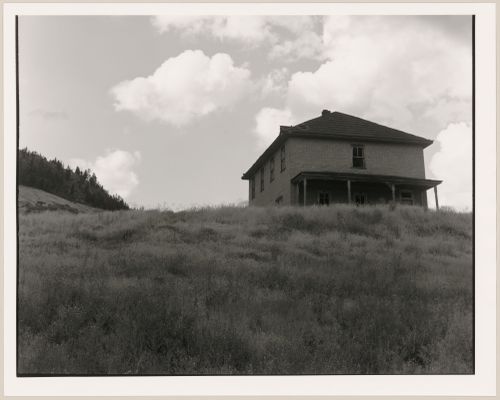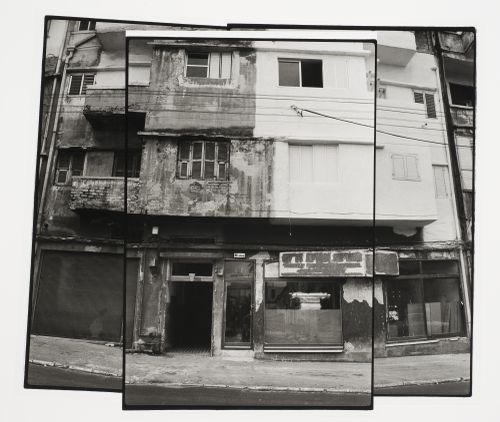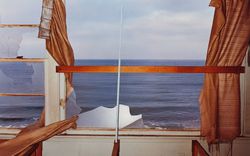PH1979:0503:003
1974
PH2001:0049:001-003
architecture
1993
Photomontage of apartment houses and an abandoned store, Tel Aviv, Israel
Actions:
PH2001:0049:001-003
architecture
Project
House X
AP143.S4.D20
Description:
File documents an unexecuted project for House X, designed for Mr. and Mrs. Arnold Aronoff for a 40-acre site on Lahser Road, Bloomfield Hills, Michigan. The ground floor consists of a kitchen, dining room, breakfast room, laundry room, two powder rooms and two garages. The second floor consists of a master suite with study, two bedrooms, bathroom, family and living rooms, bar, bathhouse and deck. The third floor consists of a solarium, terrace, bedroom and maid's room with bathroom. A swimming pool, tennis court and gatehouse are situated on the grounds. Thirteen schemes were developed for this project: A, A1, B, C, C1, C2, D, E, E1, E2, F, G, H. Only schemes G and H were developed into detailed floor plans. The drawings have been organized by drawing type, because of the subtle variations which characterize each scheme. Eisenman manipulates the four "els" (fragmentary forms - the three-sided portion of a hollow cube - that he introduced in House X to replace the cube, the preferred generating volume of his first five houses) in over 200 conceptual drawings (DR1994:0138:001-0219). There are numerous design development and complete sets of working drawings (design development drawings: DR1994:0138:239-541; working drawings: DR1994:0138:1182-1457). The project was extensively published, and the file includes a number of drawings and models created for exhibition and publication, including photographs of models (DR1994:0138:1481-1501), pieces of the "axonometric model" constructed after the project had been abandoned (DR1994:0138:1458-1476), and coloured paper cut-outs for collages (cut-outs, DR1994:0138:0929-0933 and DR1994:0138:1477-1480; collage: DR1994:0138:0928). The file also includes drawings and reprographic copies for the following projects: a residence for Mr. and Mrs. Aronoff,designed by Irving E. Palmquist, (DR1994:0138:1512-1521); Bernstein House, Mamaroneck, New York, designed by John Hejduk (DR1994:0138:1524-1531); Maison Domino by Le Corbusier (DR1994:0138:0944-0965); and land subdivision and houses for Arnold Aronoff, designed by Eisenman (DR1994:0138:0434-0441). Material in this file was produced between 1960 and 1977. File contains conceptual drawings, design development drawings, photographic materials, presentation drawings, presentation panels, publication drawings, record drawings, schematic drawings, a study model, textual records, and working drawings.
1960-1977
House X
Actions:
AP143.S4.D20
Description:
File documents an unexecuted project for House X, designed for Mr. and Mrs. Arnold Aronoff for a 40-acre site on Lahser Road, Bloomfield Hills, Michigan. The ground floor consists of a kitchen, dining room, breakfast room, laundry room, two powder rooms and two garages. The second floor consists of a master suite with study, two bedrooms, bathroom, family and living rooms, bar, bathhouse and deck. The third floor consists of a solarium, terrace, bedroom and maid's room with bathroom. A swimming pool, tennis court and gatehouse are situated on the grounds. Thirteen schemes were developed for this project: A, A1, B, C, C1, C2, D, E, E1, E2, F, G, H. Only schemes G and H were developed into detailed floor plans. The drawings have been organized by drawing type, because of the subtle variations which characterize each scheme. Eisenman manipulates the four "els" (fragmentary forms - the three-sided portion of a hollow cube - that he introduced in House X to replace the cube, the preferred generating volume of his first five houses) in over 200 conceptual drawings (DR1994:0138:001-0219). There are numerous design development and complete sets of working drawings (design development drawings: DR1994:0138:239-541; working drawings: DR1994:0138:1182-1457). The project was extensively published, and the file includes a number of drawings and models created for exhibition and publication, including photographs of models (DR1994:0138:1481-1501), pieces of the "axonometric model" constructed after the project had been abandoned (DR1994:0138:1458-1476), and coloured paper cut-outs for collages (cut-outs, DR1994:0138:0929-0933 and DR1994:0138:1477-1480; collage: DR1994:0138:0928). The file also includes drawings and reprographic copies for the following projects: a residence for Mr. and Mrs. Aronoff,designed by Irving E. Palmquist, (DR1994:0138:1512-1521); Bernstein House, Mamaroneck, New York, designed by John Hejduk (DR1994:0138:1524-1531); Maison Domino by Le Corbusier (DR1994:0138:0944-0965); and land subdivision and houses for Arnold Aronoff, designed by Eisenman (DR1994:0138:0434-0441). Material in this file was produced between 1960 and 1977. File contains conceptual drawings, design development drawings, photographic materials, presentation drawings, presentation panels, publication drawings, record drawings, schematic drawings, a study model, textual records, and working drawings.
File 20
1960-1977
Project
Ice House I (1971)
AP207.S1.1971.PR06
Description:
The project series documents the project "Ice House I" for which Pettena once again studied the transformation of a building overtaken by nature. The project consisted of pouring water on the walls of an abandoned school building in Minneapolis and letting it freeze during the night to obtain a building covered by ice. "The school preserved its typology, the typical form of that typology, but once coated in ice it was the material that transformed it: it came alive, for it had been worked by nature." It is unclear if this project was ever performed. The project series contains photographs of the frozen building, sketches, a perspective drawing, and project descriptions in English and in Italian. Source: [1] Gianni Pettena website, https://www.giannipettena.it/italiano/opere-1/nat-ice-house-i-1971-1/ (last accessed 11 November 2019)
circa 1971-2015
Ice House I (1971)
Actions:
AP207.S1.1971.PR06
Description:
The project series documents the project "Ice House I" for which Pettena once again studied the transformation of a building overtaken by nature. The project consisted of pouring water on the walls of an abandoned school building in Minneapolis and letting it freeze during the night to obtain a building covered by ice. "The school preserved its typology, the typical form of that typology, but once coated in ice it was the material that transformed it: it came alive, for it had been worked by nature." It is unclear if this project was ever performed. The project series contains photographs of the frozen building, sketches, a perspective drawing, and project descriptions in English and in Italian. Source: [1] Gianni Pettena website, https://www.giannipettena.it/italiano/opere-1/nat-ice-house-i-1971-1/ (last accessed 11 November 2019)
Project
circa 1971-2015
articles
What the future looked like
Project
CI005.S1.1927.PR1
Description:
The Kiefhoek housing scheme of 1925-1930 was initiated by the city of Rotterdam to provide affordable housing to working class residents. The Kiefhoek church of the Hersteld Apostolische Gemeente, or the New Apostolic Church, was intended as a communal space for residents of the Kiefhoek housing estate. Oud designed the church building, a verger's house and a green. The design includes a symmetrical orthogonal church hall and two blocks for the vestry and storage shed. Oud undertook the project without pay as he felt it was integral to the overall design of the complex. His original design consisted of a hippodrome-shaped building, which he later abandoned to create a unified dwelling, green and church (Taverne et al. 2001, 286-288). Project series includes drawings of plans for the Kiefhoek Church as well as photographs of the church's principle facade.
1927
Kiefhoek Church (Housing Estate), Rotterdam, Netherlands (1927)
Actions:
CI005.S1.1927.PR1
Description:
The Kiefhoek housing scheme of 1925-1930 was initiated by the city of Rotterdam to provide affordable housing to working class residents. The Kiefhoek church of the Hersteld Apostolische Gemeente, or the New Apostolic Church, was intended as a communal space for residents of the Kiefhoek housing estate. Oud designed the church building, a verger's house and a green. The design includes a symmetrical orthogonal church hall and two blocks for the vestry and storage shed. Oud undertook the project without pay as he felt it was integral to the overall design of the complex. His original design consisted of a hippodrome-shaped building, which he later abandoned to create a unified dwelling, green and church (Taverne et al. 2001, 286-288). Project series includes drawings of plans for the Kiefhoek Church as well as photographs of the church's principle facade.
project
1927
Series
Publications
AP164.S2
Description:
This series documents publications by Ábalos&Herreros and by the firm's publishing house Liga Multimedia Internaciónal (LMI). It includes a doctoral thesis “La Casa de Don Giovanni” by D. José Queglas; a book series titled “Exit”; writings about the firm for an issue of 2G: International Architecture Review, no. 22; “Técnica y architectura en la ciudad contemporánea” by Abalos & Herreros; as well as various publications by Abalos & Herreros and other authors. “La Casa de Don Giovanni” by D. José Queglas was published at the LMI. Documenting the publication are copies of the doctoral thesis, dummies, proofs, correspondence, contracts, reports, and an ISBN (International Standard Book Number) request form. Material was produced between 1972 and 1996. The book series “Exit” was also published by the LMI. Five titles were published and a sixth was in development, when the project was abandoned for unknown reasons. The publications in the series were titled: Exit 1: Exit; Exit 2: Las Afueras : siete visiones de la vida metropolitana; Exit 3: Le Corbusier. Rascacielos; Exit 4: [unknown]; and Exit 5: Natural artificial. Exit 2’s project title was “Madrid Metrópolis” and was changed later to “Las Afueras […]”. However, Abalos & Herreros did publish a book entitled “Madrid Metrópolis”, but there is no relation between the two publications. Documenting the book series are correspondence, a dummy, publications, notes, clippings, plans, invoices, contracts, and reference, digital, graphic and photographic materials. The publication “Abalos & Herreros” featured in the 2G: International architecture review, no 22 includes plans and illustrations. The issue is about Abalos & Herreros’ work from the 1990s. Documenting the publication are design development, presentation, and work drawings, as well as textual records. The publication of “Técnica y architectura en la ciudad contemporánea” by Abalos & Herreros was documented in phases of its creation. This publication was translated in English under the title “Tower and Office: from Modernist Theory to Contemporary Practice”. It was published as Buell Center / Columbia Books of Practice by MIT Press. Documenting the publication are proofs, illustrations, design development drawings, correspondence, reference and photographic materials. Various publications by Abalos & Herreros and titles published by the firm’s publishing house LMI include writings and correspondence, as well as reference, graphic and photographic materials.
1920, 1990-2008
Publications
Actions:
AP164.S2
Description:
This series documents publications by Ábalos&Herreros and by the firm's publishing house Liga Multimedia Internaciónal (LMI). It includes a doctoral thesis “La Casa de Don Giovanni” by D. José Queglas; a book series titled “Exit”; writings about the firm for an issue of 2G: International Architecture Review, no. 22; “Técnica y architectura en la ciudad contemporánea” by Abalos & Herreros; as well as various publications by Abalos & Herreros and other authors. “La Casa de Don Giovanni” by D. José Queglas was published at the LMI. Documenting the publication are copies of the doctoral thesis, dummies, proofs, correspondence, contracts, reports, and an ISBN (International Standard Book Number) request form. Material was produced between 1972 and 1996. The book series “Exit” was also published by the LMI. Five titles were published and a sixth was in development, when the project was abandoned for unknown reasons. The publications in the series were titled: Exit 1: Exit; Exit 2: Las Afueras : siete visiones de la vida metropolitana; Exit 3: Le Corbusier. Rascacielos; Exit 4: [unknown]; and Exit 5: Natural artificial. Exit 2’s project title was “Madrid Metrópolis” and was changed later to “Las Afueras […]”. However, Abalos & Herreros did publish a book entitled “Madrid Metrópolis”, but there is no relation between the two publications. Documenting the book series are correspondence, a dummy, publications, notes, clippings, plans, invoices, contracts, and reference, digital, graphic and photographic materials. The publication “Abalos & Herreros” featured in the 2G: International architecture review, no 22 includes plans and illustrations. The issue is about Abalos & Herreros’ work from the 1990s. Documenting the publication are design development, presentation, and work drawings, as well as textual records. The publication of “Técnica y architectura en la ciudad contemporánea” by Abalos & Herreros was documented in phases of its creation. This publication was translated in English under the title “Tower and Office: from Modernist Theory to Contemporary Practice”. It was published as Buell Center / Columbia Books of Practice by MIT Press. Documenting the publication are proofs, illustrations, design development drawings, correspondence, reference and photographic materials. Various publications by Abalos & Herreros and titles published by the firm’s publishing house LMI include writings and correspondence, as well as reference, graphic and photographic materials.
Series
1920, 1990-2008
archives
Level of archival description:
Fonds
CP138
Synopsis:
The Gordon Matta-Clark collection documents the personal and professional activities of Gordon Matta-Clark through his correspondence, texts, library, artwork and films, created predominantly between 1969 and 1978. Additionally the collection contains correspondence and photographs collected by Anne Alpert, Matta-Clark's mother, and documentation on his work collected by his widow Jane Crawford following his death.
1914-2008
Gordon Matta-Clark collection
Actions:
CP138
Synopsis:
The Gordon Matta-Clark collection documents the personal and professional activities of Gordon Matta-Clark through his correspondence, texts, library, artwork and films, created predominantly between 1969 and 1978. Additionally the collection contains correspondence and photographs collected by Anne Alpert, Matta-Clark's mother, and documentation on his work collected by his widow Jane Crawford following his death.
archives
Level of archival description:
Collection
1914-2008
archives
Level of archival description:
Fonds
AP128
Synopsis:
The Harold Ship Alexis Nihon Plaza and Nuns’ Island Master Plan project records, (1956- 1973), document architect Harold Ship’s design and plan for the Alexis Nihon Plaza (1956-1965) and the Nun’s Island Master Plan (1959-1973). Materials in these project records consist of 1 619 drawings (including reprographic copies), 330 photographs, 5 l.m. of textual records, 5 models and 2 panels.
1956-1973
Harold Ship Alexis Nihon Plaza and Nuns’ Island Master Plan project records
Actions:
AP128
Synopsis:
The Harold Ship Alexis Nihon Plaza and Nuns’ Island Master Plan project records, (1956- 1973), document architect Harold Ship’s design and plan for the Alexis Nihon Plaza (1956-1965) and the Nun’s Island Master Plan (1959-1973). Materials in these project records consist of 1 619 drawings (including reprographic copies), 330 photographs, 5 l.m. of textual records, 5 models and 2 panels.
archives
Level of archival description:
Fonds
1956-1973
books
Description:
19 pages : illustrations ; 24 cm
New York : Charity Organization Society, [1936]
Why abandoned buildings should be demolished / Tenement House Committee.
Actions:
Holdings:
Description:
19 pages : illustrations ; 24 cm
books
New York : Charity Organization Society, [1936]


